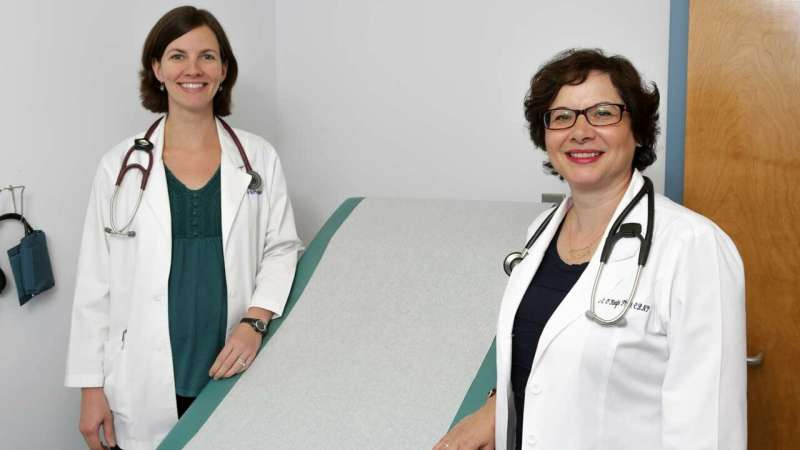Amber McPhail, UAH’s director of Student Health Services, and Dr. Louise O’Keefe, director of UAH’s Faculty and Staff Clinic, previewed GeneCapture’s new technology for rapid antibiotic sensitivity testing. Credit: University of Alabama in Huntsville
Scientists at GeneCapture, Inc., an associate company on the campus of the HudsonAlpha Institute for Biotechnology, have developed a method to report phenotypic antibiotic sensitivities/resistances direct from patient samples in only 5-75 minutes. The patent-pending technology is being developed for point of care and emergency applications.
Currently, it takes up to a few days to identify a pathogen and determine its antibiotic susceptibility. GeneCapture's rapid CAPTURE platform is able to identify the causative pathogen in about 45 minutes, and now they have developed a reflex assay that will test the effectiveness of various antibiotics against that pathogen in an additional five to 75 minutes. Both the identification (ID) and sensitivity tests will be available for use at clinics or other point-of-care sites, allowing a doctor to prescribe the most effective antibiotic within about an hour of seeing a patient. Using targeted antibiotic treatment results in better patient outcomes and improves antimicrobial stewardship.
This week, scientists from GeneCapture previewed the data collected from their functioning prototype, the "C-AST" antibiotic sensitivity testing (AST) system, and previewed the envisioned AST device for the directors of the Faculty and Student Clinic and the Student Health Center at The University of Alabama in Huntsville (UAH). These clinics have collaborated with GeneCapture in the past by providing samples and operational expertise as well as participating in joint research.
"This new AST capability is a game changer," says Dr. Krishnan Chittur, co-founder of GeneCapture. "Our goal is to speed up diagnosis, so people get treated quickly and with the right antibiotic medication."
The AST technology uses actual patient samples challenged with breakpoint concentrations of various drugs that may be effective against the identified bacteria or fungus. The machine-learning algorithm reports sensitivity or resistance by interpreting optical scanning of the sample at various wavelengths.
"Antibiotic overuse is a threat to all of us because of growing antibiotic resistance, so unless it's the right antibiotic, we're just leaving the door open for more resistant bugs to infect us in the future. We've found a novel technology solution, and now we are designing the product to be efficient and cost-effective for the clinic," says Paula Koelle, chief scientist at GeneCapture. "The feedback we received from our clinic collaborators matches with our plan to seamlessly fit our tests into standard clinic protocol, reducing the time, suffering and cost for the patient."
The data presented this week included tests with four antibiotics (both bactericidal and bacteriostatic) against nine organisms that are the most prevalent causes of urinary tract infections. Multiple strains of these organisms were tested, and in 25 runs, the rapid AST assay performed identically to culture results but in a fraction of the time.
"We appreciate the diligence and passion of the GeneCapture team in developing products that will positively impact patient and clinic experience, especially in remote areas that have limited access to laboratories," says Dr. Louise O'Keefe, who serves as director of the UAH Faculty and Staff Clinic.
Provided by University of Alabama in Huntsville























